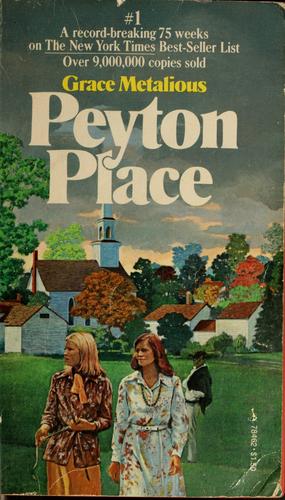Peyton Place
When it was first published in 1956, Grace Metalious’ debut novel Peyton Place shocked the world. Deemed morally corrupting “trash,” the book was banned in multiple cities and countries, including Canada. Nevertheless, the book remained on The New York Times’ bestsellers list for fifty-nine weeks, gaining such notoriety that it eventually was adapted into not only a movie but a long running TV soap opera. What was it, then, that made a book about a small New England town so controversial?
The story is remarkably simple. Set during World War II, the book follows the lives of three women – single mother Constance MacKenzie, her daughter Allison, and Allison’s friend Selena Cross. Lonely and repressed, Constance’s life is ruled by the fear that her past adulterous relationship will become known to her gossipy town. Meanwhile, her daughter Allison grapples with adolescence, straddling the line between following her mother’s strict rules and desiring to explore her sexuality. Although going through a similar transition, Selena Cross is subjected to a much darker world than Allison – one where the sexual appetite of an older man threatens to ruin her life.
Through these three women, Metalious brings to the forefront taboo issues of 1950’s society that are often swept under the rug. Along with detailing the social inequalities and class privilege running rampant in society at the time – and which continue to do so today – the book takes a hard and honest look at the issue of female sexuality, specifically, women as active sexual agents. The women of Peyton Place not only have sex, but they enjoy it. This perhaps sparked the most controversy. That is, it wasn’t so much the sex itself, but it was the way in which Metalious celebrated female sexuality that was considered scandalous and uncouth. By dealing with related issues of domestic violence, rape, abortion, and adultery, Metalious unapologetically comments on the harsh realities society turned a blind eye to. In doing so, she rips apart the glossy image of moral, friendly, buttoned-up small town America to expose the harsh realities underneath.
Now, you might be wondering how a book that deals with such “unseemly” topics, written by a woman no less, even got published. At the time, there were only two female presidents of publishing companies. Kitty Messner, president of Julian Messner, and Helen Meyer, head of Dell Publishing. When Messner first read the manuscript, she, along with her almost entirely female staff, recognised its potential immediately. After signing a deal with Metalious, Messner enlisted the help of Meyer to actually print the book. It was specifically the book’s progressive, blunt portrayal of taboo subjects that drew both women to the story. They knew that if they and their staff loved it, there was bound to be a market out there of readers who yearned for authenticity too. And they were right.
So, why should you read Peyton Place? For starters, you can’t just watch the film or TV adaptation. Neither captures the spirit or social commentary. They either drastically change the material’s controversies or remove them altogether to better suit conservative norms. More importantly though, it allows us to rethink the past. Yes, 1950’s America had strict norms – a post-McCarthyism era of repression, denial, regulation, and hushed-whispers about ‘improper’ things. However, by reading Metalious’ work, we can see that it wasn’t just that. It was a time of change, of pushing boundaries, and bringing what was hidden into the light. Perhaps most simply, it’s a good story told by a good storyteller. It has it all. Love. Loss. Sex. Murder. Scandal. What more could you ask for?
